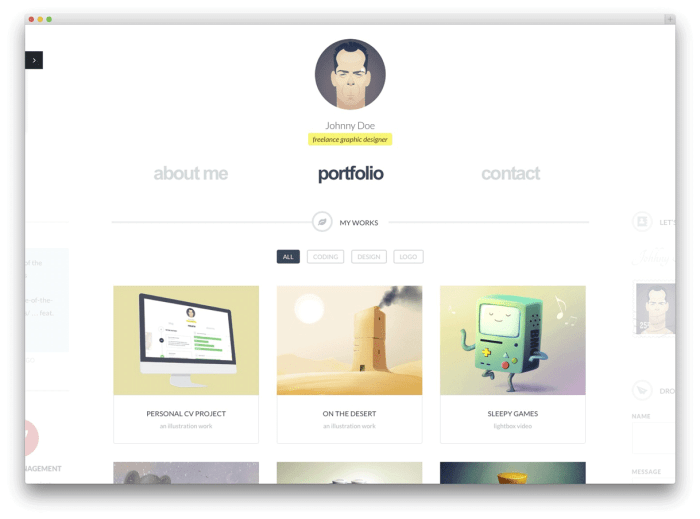Building an Online Portfolio kicks off a journey into the digital world where professionals can display their talents and accomplishments in a visually appealing manner that speaks volumes about their expertise. As we delve into the realm of online portfolios, get ready to explore the key elements that make a standout portfolio and how to effectively promote your work to the world.
Overview of Building an Online Portfolio
Having an online portfolio is crucial in today’s digital age as it serves as a virtual resume that showcases your work, skills, and expertise to potential employers or clients.
An online portfolio allows individuals to highlight their accomplishments, projects, and experiences in a visually appealing and organized manner, making it easier for others to understand the value they can bring to the table.
Benefits of Building an Online Portfolio
- Increased Visibility: By creating an online portfolio, professionals can increase their visibility and reach a wider audience, making it easier for them to attract new opportunities.
- Showcasing Skills: An online portfolio provides a platform to display one’s skills and expertise through examples of past work, case studies, and testimonials, helping to build credibility and trust.
- Personal Branding: Building an online portfolio allows individuals to establish a strong personal brand and differentiate themselves from competitors in the industry, creating a unique identity that resonates with their target audience.
- Networking Opportunities: An online portfolio can serve as a powerful networking tool, enabling professionals to connect with like-minded individuals, potential clients, and industry experts, leading to collaborations and career growth.
Planning Your Online Portfolio
When planning your online portfolio, there are several key elements to consider to ensure it effectively showcases your work and accomplishments. Choosing the right platform for hosting your portfolio is crucial, as it can impact how your work is presented and viewed by potential employers or clients. Setting clear goals and defining your target audience will help you tailor your portfolio to meet the needs and expectations of those who will be viewing it.
Key Elements to Consider
- Choose a clean and professional design that highlights your work without distractions.
- Organize your portfolio in a logical manner, making it easy for visitors to navigate and find what they are looking for.
- Showcase a diverse range of projects that demonstrate your skills and expertise in different areas.
- Include a brief bio or introduction that provides context about you and your background.
Choosing the Right Platform
- Consider platforms like WordPress, Wix, or Squarespace that offer customizable templates and easy-to-use interfaces.
- Look for platforms that support multimedia content, such as images, videos, and interactive elements.
- Ensure the platform you choose is mobile-responsive, as many visitors will be viewing your portfolio on their smartphones or tablets.
Setting Goals and Defining Your Audience
- Determine what you want to achieve with your portfolio, whether it’s landing a job, attracting clients, or showcasing your skills.
- Identify your target audience – potential employers, clients, industry professionals – and tailor your portfolio to appeal to their preferences and expectations.
- Keep your goals and audience in mind as you curate and update your portfolio to ensure it stays relevant and impactful.
Design and Content Creation

When it comes to building an online portfolio, the design and content are crucial aspects that can make or break your first impression. A visually appealing portfolio with compelling content can help you stand out and showcase your work effectively.
Designing an Engaging Online Portfolio
- Keep it clean and organized: Use a simple layout with easy navigation to highlight your work.
- Choose a cohesive color scheme: Select colors that complement your work and reflect your personal brand.
- Utilize white space: Allow for breathing room between elements to avoid a cluttered look.
- Opt for responsive design: Ensure your portfolio is mobile-friendly for easy viewing on all devices.
Creating Compelling Content
- Showcase your best work: Feature your most impressive projects prominently to grab attention.
- Provide context: Briefly explain each project, including your role, goals, and the skills utilized.
- Include client testimonials: Adding testimonials can build credibility and trust with potential clients or employers.
- Update regularly: Keep your portfolio fresh with new projects and achievements to demonstrate growth.
Using Multimedia Elements
- Images: Use high-quality images to visually represent your work and create a strong visual impact.
- Videos: Incorporate videos to showcase dynamic projects or provide a behind-the-scenes look at your process.
- Testimonials: Include written or video testimonials from satisfied clients or colleagues to add social proof.
Showcasing Your Work
When it comes to showcasing your work in your online portfolio, organization is key. You want to make it easy for visitors to navigate and explore your projects. Categorizing your work can help with this, grouping similar pieces together for a cohesive viewing experience.
Organizing and Categorizing Your Work
- Consider creating separate sections for different types of projects, such as web design, photography, writing, etc.
- Use clear labels and tags to help visitors find specific pieces they may be interested in.
- Showcase your best work prominently, but also provide a variety to showcase your range of skills and talents.
Creating a Cohesive Narrative or Theme, Building an Online Portfolio
To tie your work together, consider creating a narrative or theme that runs through your portfolio. This could be a specific style, color scheme, or even a story that connects your projects. This helps create a sense of unity and purpose in your portfolio.
Regularly Updating Your Portfolio
It’s important to keep your online portfolio up to date with your latest projects. Regularly adding new work not only shows that you are active and engaged in your field but also gives visitors a reason to come back and see what’s new. Don’t let your portfolio become stale – keep it fresh and engaging.
Promoting Your Online Portfolio: Building An Online Portfolio

To ensure that your online portfolio gets the attention it deserves, you need to actively promote it and drive traffic to it. Utilizing social media, networking, and search engine optimization are essential strategies for increasing visibility and reaching a wider audience.
Utilizing Social Media and Networking
When it comes to promoting your online portfolio, social media platforms are your best friends. Share your work regularly on platforms like Instagram, Twitter, LinkedIn, and Facebook to showcase your talent and attract potential clients or employers. Engage with your followers, participate in relevant online communities, and collaborate with other professionals to expand your network and increase exposure.
Optimizing for Search Engines
Optimizing your online portfolio for search engines is crucial for improving visibility and attracting organic traffic. Make sure to use relevant s in your portfolio content, meta descriptions, and image alt text to improve your chances of appearing in search results. Regularly update your portfolio with fresh content and ensure that your website is mobile-friendly and loads quickly to enhance user experience and search engine rankings.
Driving Traffic Through Promotion
In addition to social media and , consider other promotional tactics to drive traffic to your online portfolio. Guest posting on industry websites, running targeted online ads, and participating in online forums or communities can help you reach a wider audience and attract more visitors to your portfolio. Collaborating with influencers or industry experts can also boost your portfolio’s visibility and credibility.





